Ticks | Ticks | Ticks
by Kathleen Wilson
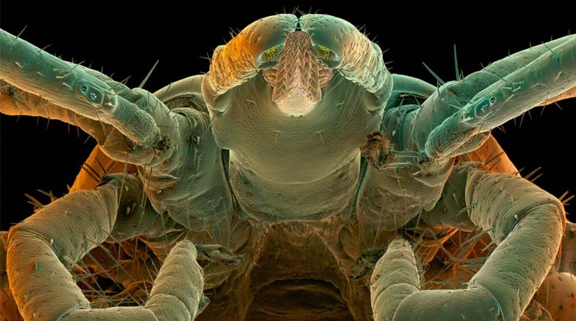
White-Footed Mice, Black-Legged Ticks, and White-Tailed Deer
Some Interesting Facts about Ticks & Tick-Borne Disease
- Tick-borne diseases are relatively recent, and rising >>
- Ticks are not born carrying diseases, like Lyme. Blame the white-footed mouse for infecting them >>
- Connecticut is home to four types of ticks. Not all of them carry disease >>
- The hosts that ticks feed on tend to vary as they move through their two-year life cycle >>
- Ticks prefer specific habitats – beware of invasive tick magnet plants like Japanese Barberry! >>
- Acorns can play a role in the cycle of deer, mice, ticks and Lyme disease >>
- Red foxes and guinea fowl – Ticks have natural predators that can be used to keep their numbers in check >>
- Experimental approaches to tick-born disease reduction are underway – vaccines and gene editing >>
- Protection from ticks should be multi-pronged – Protect People, Pets, Property >>
- Lyme disease is not always easy to detect – common symptoms and treatment >>
- Articles of interest – sources and resources >>
(1) Tick-borne diseases are relatively recent … and rising.
Ticks have been around for 300 million years, but they haven’t been known carriers of disease for nearly as long. Lyme disease, for example, was first discovered as recently as the late 1970s. Further back in time, Babesia, one of the first pathogens known to be carried by ticks, was discovered by veterinarians in the 1890s in cows that were dying by the thousands, but it was not until 1957 that the first case of Babesiosis, which has similar symptoms to Lyme disease, was recorded in humans.
Tick-borne disease is now a rising problem worldwide. In the United States alone the reported incidence of tick-borne disease doubled between 2004 and 2016. In addition, the geographic range of ticks has expanded, and researchers have discovered seven new tickborne pathogens that infect people. Cases of Lyme disease, anaplasmosis/ehrlichiosis, spotted fever rickettsiosis (including Rocky Mountain spotted fever), babesiosis, tularemia, and Powassan virus disease have all increased—from 48,610 cases in 2016 to 59,349 cases in 2017 alone. Since under-reporting of tick-borne diseases is known to be extremely common, the number of people actually infected is assumed to be much higher.
A number of factors may be contributing to the dramatic rise of tick-borne disease, including the reforestation of suburban areas, increased human travel, a lack of vaccines to treat tick-borne diseases in people and the migration of ticks into areas that were once considered too cold for them to survive.
(2) Ticks are not born carrying diseases, like Lyme. Blame the white-footed mouse for infecting them.
Because ticks need to feed on blood in order to survive, it is only if and when they feed on the blood of a host infected with bacteria like Borrelia burgdorferi which causes Lyme disease that they become carriers. White-footed mice are often the blood hosts that infect ticks with Lyme disease.
 As ticks move through their two-year life cycle, growing from eggs to six-legged larvae to eight-legged nymphs to adults, the blood hosts they feed on vary. At the larva and nymph stages, for example, ticks tend to feed on mice, small birds and other rodents, all of which are natural reservoirs of bacteria like Borrelia burgdorferi.
As ticks move through their two-year life cycle, growing from eggs to six-legged larvae to eight-legged nymphs to adults, the blood hosts they feed on vary. At the larva and nymph stages, for example, ticks tend to feed on mice, small birds and other rodents, all of which are natural reservoirs of bacteria like Borrelia burgdorferi.
White-footed mice, in particular, are a problem in many areas of the country. Not only are they the most common rodent species in North America, but forty to ninety percent of them are also known to carry Borrelia burgdorferi, as well as other diseases including Babesiosis, Anaplasmosis, Powassan encephalitis and Hantavirus. It’s highly likely that tick larvae or nymphs feeding on white-footed mice will become infected. Tick nymphs infected with Lyme bacteria pose the biggest threat to humans; the numbers of infected tick nymphs are linked with the size of mouse populations.
(3) Connecticut is home to four types of ticks. Not all of them carry disease.
Approximately 878 species of ticks, including hard and soft ticks, have been found worldwide. The most common ticks to prey on people and pets are hard ticks. In CT, the black-legged tick is the most likely to transmit disease.
CT’s four varieties of ticks include:
The Black-Legged (Deer) Tick – the most likely tick to infect people & pets in CT with Lyme disease, Babesiosis and/or Anaplasmosis. Co-infections are not uncommon.
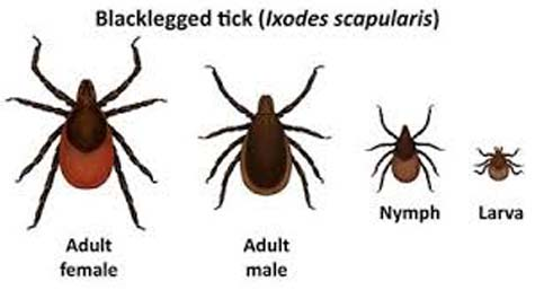
The American Dog (Wood) Tick – much bigger than the black-legged tick, can carry Rocky Mountain Spotted Fever but rarely in CT.
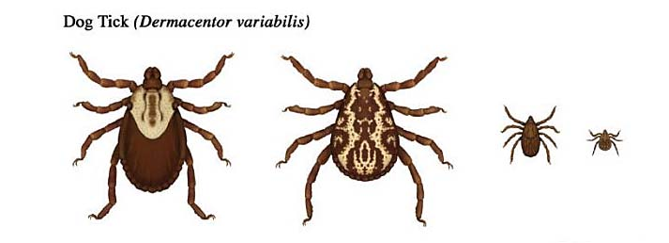
The Brown Dog Tick – feed on dogs, but rarely people.
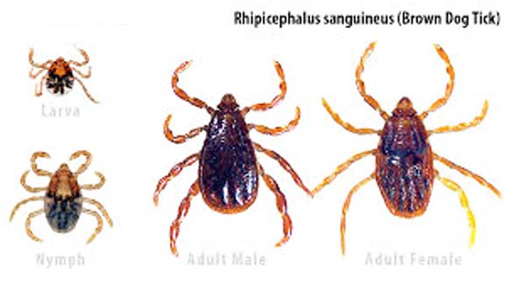
The Lone Star Tick (rare in CT, found most recently along the southern coast) – can infect people and pets with Erlichiosis.
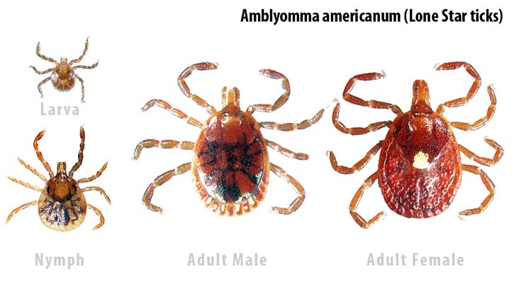
(4) The hosts that ticks feed on tend to vary as they move through their two-year life cycle.
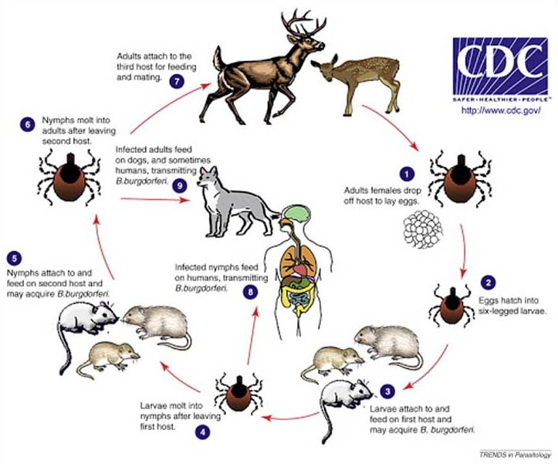
Eggs. Female ticks need a blood meal before reproducing. They tend to breed in early spring (April/May) on a large host animal, such as the white-tailed deer, then drop to the ground once engorged with blood to lay their eggs, typically in leaf litter. It is not uncommon for a single tick to lay a few thousand eggs (anywhere from 1,500 to > 5,000). In order to develop from eggs to larvae to nymphs to adults, ticks must find blood hosts to feed on at each stage.
Larvae. After about two weeks, ticks hatch from eggs into tiny, six-legged larvae about the size of poppy seeds (less than 1/8th inch). Due to the small size of larval ticks, hosts at this stage tend to be birds and rodents, such as white-footed mice. Larval ticks cannot jump, run or fly, but they can make their way from the ground up to the tops of tall grasses, shrubs and plants where they are in a good position to grab onto passing potential hosts. Signals such as elevated CO2 levels, breath, body odor, body heat, moisture, vibration, and even shadows alert ticks to the presence of potential hosts. Larval ticks are patient. They can survive for more than a year (up to 540 days) without feeding. After feeding on a host for several days, once full, larval ticks drop to the ground where they remain inactive over the winter until the following spring when they shed their skins and become eight-legged nymphs.
Nymphs. In late spring and early summer, new nymphs seek out blood hosts, which tend to be larger mammals, such as chipmunks, grey squirrels, raccoons, skunks, possums, household pets and people. After filling with blood from these hosts, the nymphs drop to the ground, shed their skins and finally emerge as adults.
Adults. In the fall, adult ticks (up to 5/8 of an inch in size) seek out even larger hosts, particularly deer and livestock, but also people and pets, for their blood meals. It’s interesting to note that deer do not infect ticks with Lyme disease. They also do not contract Lyme disease when an infected tick feeds on them. As long as the temperature remains above 35 degrees, ticks continue to feed. They do not die over the winter. Females drop to the ground where they lay their eggs the following spring.
(5) Ticks prefer specific habitats – beware of invasive tick magnet plants like Japanese Barberry!
 Adult ticks can be found living in the grass along the edges of forests, near stone walls and wood piles, in shrubs and gardens, and anywhere with dense ground cover between ankle and waist height. A number of invasive plants, such as Japanese Barberry, Multiflora Rose and Jewelweed are known to be havens for ticks. One of the reasons for this is that small rodents, such as the white-footed mice which carry Borrelia burgdorferi, the cause of Lyme disease, are attracted to the warmth and humidity that exists in thickets of these dense, thorny shrubs.
Adult ticks can be found living in the grass along the edges of forests, near stone walls and wood piles, in shrubs and gardens, and anywhere with dense ground cover between ankle and waist height. A number of invasive plants, such as Japanese Barberry, Multiflora Rose and Jewelweed are known to be havens for ticks. One of the reasons for this is that small rodents, such as the white-footed mice which carry Borrelia burgdorferi, the cause of Lyme disease, are attracted to the warmth and humidity that exists in thickets of these dense, thorny shrubs.
(6) Acorns can play a role in the cycle of deer, ticks, mice, and Lyme disease

Acorns are an attractive food source to both white-footed mice and white-tailed deer. Adult ticks are sometimes carried to oak forests after latching onto white-tailed deer in search of acorns. Once there, the engorged ticks drop from the deer to the ground and end up spending the winter in the acorn and leaf debris under the oaks. In the spring, the female ticks lay their eggs which soon hatch into larval ticks. The tiny larval ticks in search of a blood meal then latch onto passing white-footed mice who are in search of their own meals – acorns. Typically, as mentioned above, ticks that feed on the blood of white-footed mice become infected with the bacteria the causes Lyme disease.
(7) Red Foxes and Guinea Fowl – Ticks have natural predators that can be used to keep their numbers in check
Since hosts like white-footed mice have the potential to infect ticks and ticks are known to infect people and pets, attempts to reduce the spread of tick-borne diseases by eliminating infected blood hosts have included the study of their natural predators.
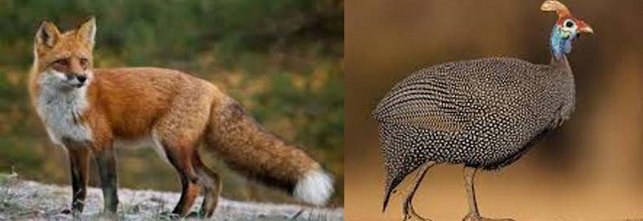 Red foxes, for example, are known to feed on white-footed mice and thus reduce the white-footed mice populations wherever they live. When coyotes are present, however, they feed on red foxes and subsequently reduce the red fox population significantly. Because coyotes are not as likely to eat white-footed mice as red foxes and white-footed mice populations tend to grow when fewer red foxes around, researchers have found that places with more coyotes and fewer red foxes have more white-footed mice and also more Lyme disease.
Red foxes, for example, are known to feed on white-footed mice and thus reduce the white-footed mice populations wherever they live. When coyotes are present, however, they feed on red foxes and subsequently reduce the red fox population significantly. Because coyotes are not as likely to eat white-footed mice as red foxes and white-footed mice populations tend to grow when fewer red foxes around, researchers have found that places with more coyotes and fewer red foxes have more white-footed mice and also more Lyme disease.
Guinea Fowl and chickens provide a natural form of pest control, often eating incredible quantities of ticks, mosquitos and fleas. Guinea fowl have been known to eat as many as 4,000 ticks a day. Chickens, too, eat lots of ticks. One study of free-range chickens in a tick-infested cattle field found that they ate an average of more than 80 ticks within a 30 to 60-minute time frame.
(8) Experimental Approaches to Tick-Borne Disease Reduction are Underway
Developing vaccines for people
From 1999 to 2002 a Lyme vaccine for people called LYMErix was sold by SmithKlineBeecham (now GlaxoSmithKline). LYMErix is the vaccine still used today to immunize dogs against Lyme disease. Although LYMErix was shown to be quite effective with people, it was pulled from the market due to studies showing the potential for some patients to develop a harmful immune response to the vaccine. U.S. Biologic is now seeking approval to market a repurposed version of LYMErix developed by a veterinarian at the University of Tennessee as an oral vaccine for the white-footed mice that carry Lyme disease. Over the years several other companies have attempted to develop Lyme vaccines for people but none so far have brought them to market. In 2013, Valneva, a French biotech company, began working on a Lyme vaccine for people which is now in phase-two clinical trials and could be in a position to seek regulatory approval by 2024.
Editing the Genes of White-Footed Mice to Fight Lyme Disease
The prevalence of infected ticks near places people live has been inadvertently maximized by the fact that housing developments and roads have cut through and fragmented the forest environments that are home to the three main players in the cycle of tick-borne disease transmission: white-tailed deer (act as hosts to egg-laying adult ticks), white-footed mice (infect ticks with pathogens), and black-legged ticks (acquire and transmit pathogens to humans and pets). Mice Against Ticks is a community-guided project designed to try to stop this cycle by combining and editing Lyme resistant genes evolved by some white-footed mice so that they can pass these modified genes on to their offspring.
(9) Protection from Ticks should be Multi-Pronged
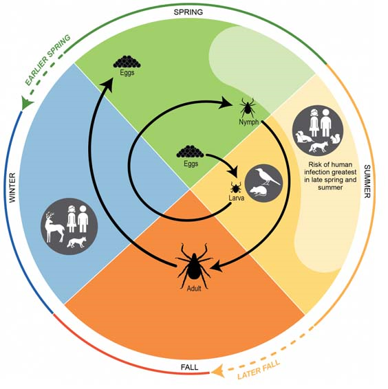 Protecting yourself
Protecting yourself
- Wear long sleeved shirts and long, light colored pants tucked into high socks.
- Wear a hat and shoes.
- Check for ticks frequently. Tick bites are hard to detect – they secret a compound while feeding that often keeps people and pets from feeling the irritation of a bite.
- Use tick removal tools or tweezers to remove ticks – it takes minimally 24 hours for ticks to transmit Lyme disease. Ticks can feed on a host for up to 5 to 10 days.
- Consider using tick repellents, such as DEET, picaridin or IR3535 on clothes and shoes.
- Send ticks you remove to The Connecticut Agricultural Experiment Station for testing.
- Become familiar with the lifecycle of ticks and the most-likely months for tick infection – late spring and summer.
Protecting your pets
- Consider natural remedies (spray solution of one-part vinegar, one-part water).
- Apply topical or oral anti-tick medication.
- Check for ticks frequently.
- If your pet is a dog, consider the Lyme vaccine (LYMErix).
Protecting your yard
- Remove leaf litter.
- Clear tall grass and brush around the edges of wooded areas.
- Mow grass frequently.
- Stack wood neatly and in a dry area.
- Place a 3-foot wide barrier of wood chips or gravel between your lawn and the woods.
- Eliminate invasive plants like Japanese Barberry.
- Consider using a yard spray with the tick-specific fungus (Metarhizium Anisopliae) which is non-toxic to humans and pets.
(10) Common Symptoms and Treatment of Lyme Infection

Lyme disease is not always easy to detect. Symptoms may not appear for days or months. About 50% of infected people may get a rash. Only about 9% get the classic bulls-eye rash. Other symptoms include flu-like fever, headache, fatigue, joint pain, neck and back pain, and/or jaw pain. Oral antibiotics prescribed by a doctor are the standard treatment for early stage Lyme disease.
(11) Articles of Interest | Sources and Resources
- About Lyme Disease Symptoms
- A Community-guided Genome Editing Project Can Fight Lyme Disease
- American Lyme Disease Foundation
- Bracing for the Worst — Range Expansion of the Lone Star Tick in the Northeastern United States (Goudarz Molaei, Ph.D., Eliza A.H. Little, Ph.D., Scott C. Williams, Ph.D., and Kirby C. Stafford, Ph.D.)
- CDC – Lyme and Other Tickborne Diseases Increasing
- The Connecticut Agricultural Experiment Station – Submitting Ticks for Testing
- Deer Tick Life Cycle and Active Periods
- Eliza Little Lays Out Latest Findings About Ticks and Tick-borne Diseases – Norfolk Now
- Gene Editing to Stop Lyme Disease: Caution is Warranted
- Guinea Fowl and Tick Control
- Here are the Biting Ticks In Connecticut, Number of Lyme Cases
- How an Invasive Plant is Helping Ticks Survive
- How Ticks Spread Disease
- Is A Tick Killing Fungus the Answer to Tick Control?
- Lifecycle of Black-Legged Ticks – Globalchange.gov
- Lyme Disease and 4 Emerging Tick-Borne Illnesses (copy article title and paste into Google search)
- Lyme Disease-Carrying White-Footed Mouse Could One Day Be Genetically Modified to Stop Spread of Tick-borne Illness
- Lyme Disease: Ten Things You Always Wanted to Know About Ticks
- Lyme Disease: You Can’t Blame the Deer
- Lyme’s Worst Enemy? It Might Be Foxes
- Of Ticks, Mice and Men
- Predation on Livestock Ticks by Chickens
- Preventing Ticks in the Yard – CDC
- Symptoms and Treatment of Lyme Disease – Mayo Clinic
- The Rise of the Tick
- The Strange Relationship between Acorns and Ticks
- Ticks – CDC
- Ticks – CT.gov
- Tick, Tick, Tick: Vector-Borne Diseases Ramp Up
- Why There’s Still No Lyme Vaccine for Humans
- Statewide tick survey finds ticks carrying 5 different diseases in CT (February 20, 2020)

With many thanks to our local tick expert, Norfolk resident, Dr. Eliza Little, Postdoctoral Fellow at The Connecticut Agricultural Experiment Station in New Haven, CT, whose interview with the CLC provided much of the inspiration for the information we’ve presented here.
The Colebrook Land Conservancy
Post Office Box 90
Colebrook, Connecticut 06021
info@colebrooklandconservancy.org

Our Mission
Preserve and conserve the special and unique characteristics of Colebrook—rural, historic and scenic—using accepted land conservation techniques and education in cooperation with the Town, the community and other groups.
